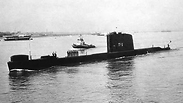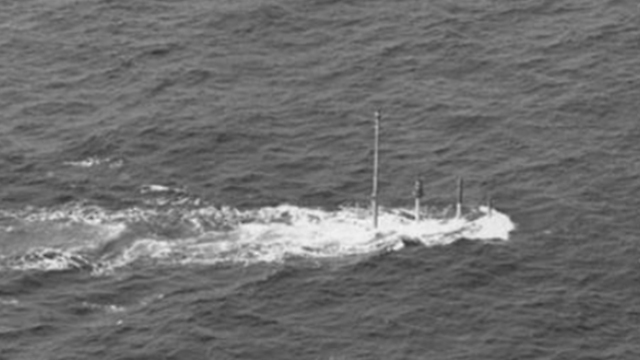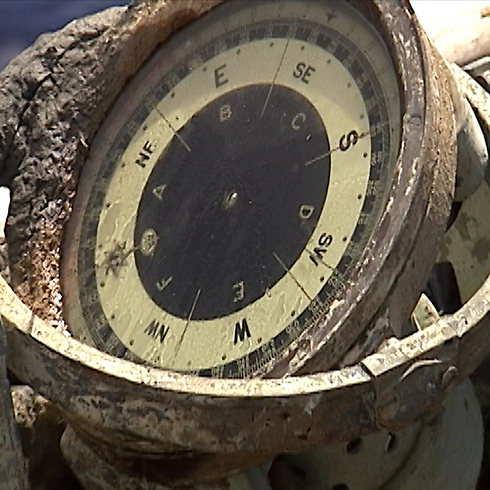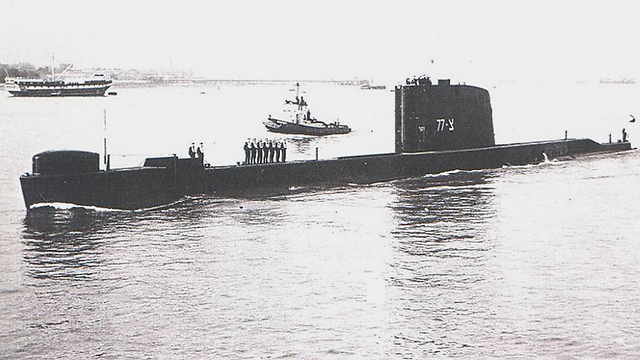
Photo: IDF Spokesperson's Unit
צילום: לע"מ
Report reveals story of Israeli sub sunk in 1968
Navy still lacks definitive evidence to explain the disappearance of the INS Dakar and its crew, but a new report has revealed the full details of the sub's doomed journey.
A technological failure or a collision with another sea-bound vessel? According to an official Navy report released Monday, these are the two options that may have led to the disappearance of Israel's Dakar submarine in 1968.


The report was delivered first to bereaved families who lost their loved ones beneath the waves in 1968, 47 years ago. The Navy stated that the report combined all data collected over the years by committees and investigations with relevance to the submarine's disappearance.
"We've narrowed down to two options that may have sunk the Dakar," said Navy Chief Ram Rothberg. "One, a technical failure that led to a loss of control until the submarine hit the sea floor at a depth of 3,000 meters; two, a collision on the stormy night in January with refuse or another sea-bound vessel... leading to a water leak into the submarine."
Rothberg followed the Navy's previous comments, saying that it could not have been a Soviet vessel that was responsible for the sinking of the Dakar.
For the first time, the new report tells the full story the Dakar's doomed voyage at sea.
The submarine's crew had requested from officials to return to port in Haifa earlier than planned to partake in a military ceremony. The Navy refused.
The INS Dakar set sail from Britain to Israel at 1pm on January 9 at the order of Major Yaakov Raanan under the operational code "Dakron." The submarine was fully burdened with food and supplies for four weeks and sailed without any weaponry.

The last-known sighting of the Dakar as photographed by the US air force. (Photo: IDF Spokesperson's Unit) (צילום: דובר צה"ל)
Dakar was outfitted with a new radar detection system developed by the Israeli Navy that had not yet been tested. Lieutenant Colonel Benny Maimon, the engineer who had developed the new technology was onboard with his precious equipment. Journalist Eran Shorar was also along for the journey, but escaped disaster by debarking during a refueling stop at Gibralter on January 15.
In following with established protocol, the Dakar was required to contact Navy command and control once every 24 hours and to send a system check every six hours.
The submarine was planned to travel at 5.5 knots due to stormy seas, but the crew pushed the envelope and cruised at 7-8 knots, allowing for their request to dock early. The Navy refused, citing that after the Six Day War, there was significant moral importance in having the crew arrive precisely for a ceremony of graduating Captains.
The Dakar was left with 24 hours to kill.

Pieces of the Dakar found at the bottom of the sea. (Photo: IDF Spokesperson's Unit) (צילום: דובר צה"ל)
The last location report received from the Dakar was on January 24, 1968 at 6:10am, just 30 miles south east of the island of Crete. Three more system checks were received as planned. The final check received from the submarine was just after midnight on January 25. The next scheduled check at 8am never came.
On the 25th and the 26th, the Navy received system checks they initially believed to be from the Dakar. Searches for the missing vessel only began one they had realized their mistake.
Israeli ships and aircraft were deployed with the help of British, US, Greek, Turkish and Lebanese vessels also searching for the Dakar.
There was reason to hope on the 27th when the Navy and forces on Cyprus picked up morse code possible coming from the Dakar, calling for help. The code continued for over an hour, but searches continued in vain.
The foreign teams withdrew from searches after four days and a British announcement that the crew could not possibly have survived for such a prolonged period of time. By February 1, Israeli search and rescue crews were the only ones left active.
But even the Israelis were forces to call off the search on February 4, 10 days after the disappearance.
Defense Minister Moshe Dayan gave the news to the families of the Dakar's crew members in person alongside then IDF Chief Chaim Bar Lev and Navy commander Shlomo Arel.
An investigative committee formed after the disaster found that the hopeful morse code had been sent from an unknown sources with mischevious purposes or in possibly intentional attempts to derail the searches.












